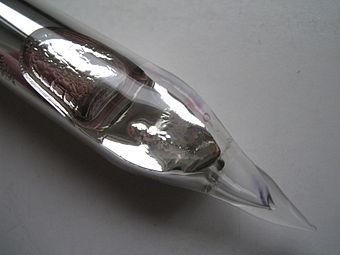Rubidium is a chemical element with the symbol Rb and atomic number 37. It is a soft, silvery-white metallic element that belongs to the alkali metal group of elements.

Physical properties of rubidium
Rubidium is a soft, silvery-white metal with the atomic number 37 and symbol Rb. Here are some of its physical properties:
- Appearance: Rubidium is a soft, ductile metal with a silvery-white appearance.
- Density: The density of rubidium is 1.532 g/cm3, which is higher than that of water.
- Melting and boiling points: Rubidium has a relatively low melting point of 39.3°C and a boiling point of 688°C.
- Atomic radius: Rubidium has a larger atomic radius than sodium and potassium, which are also alkali metals. The atomic radius of rubidium is approximately 248 picometers (pm).
- Electrical conductivity: Rubidium is a good electrical conductor, and has a relatively low resistivity of 128 nanohms per meter (nΩm) at room temperature.
- Isotopes: Rubidium has two stable isotopes: rubidium-85 and rubidium-87. Rubidium-87 is also a radioactive isotope and can be used for radiometric dating.
Overall, rubidium is a soft, silvery-white metal with physical properties that are similar to those of other alkali metals. It has a relatively low melting point and is a good electrical conductor.
Сhemical properties of rubidium
Rubidium is a highly reactive alkali metal with the atomic number 37 and symbol Rb. Here are some of its chemical properties:
- Reactivity: Rubidium is highly reactive and reacts violently with water, acids, and other substances. It is so reactive that it must be stored in an inert atmosphere or under mineral oil to prevent it from reacting with air or moisture.
- Oxidation states: Rubidium has only one stable oxidation state, which is +1. This means that rubidium loses one electron to form a positive ion when it reacts with other elements.
- Electronegativity: Rubidium is one of the most electropositive elements, which means that it readily gives up its valence electron in chemical reactions.
- Chemical compounds: Rubidium can form a variety of chemical compounds, including oxides, hydroxides, halides, sulfates, and nitrates. Some of the most important rubidium compounds include rubidium chloride, rubidium carbonate, and rubidium hydroxide.
- Flame color: When burned, rubidium produces a distinctive red-violet flame color.
- Isotopes: Rubidium has two stable isotopes, rubidium-85 and rubidium-87. Rubidium-87 is also a radioactive isotope and can be used for radiometric dating.
Application of rubidium
Overall, rubidium is a highly reactive element with a variety of chemical properties. It readily forms chemical compounds and has a distinctive flame color when burned. Its isotopes, especially rubidium-87, have important applications in scientific research and geology.
Rubidium has several important applications in science and technology. Here are some of the most significant ones:
- Atomic clocks: Rubidium is used in some types of atomic clocks, which are highly accurate timekeeping devices used in scientific research, navigation, and other applications.
- Radioactive dating: Rubidium-87 is a radioactive isotope that can be used for radiometric dating of geological samples. This method is widely used by geologists to determine the age of rocks and other materials.
- Spectroscopy: Rubidium is commonly used in spectroscopy, a technique used to study the properties of atoms and molecules. Rubidium vapor is used as a light source in some types of spectrometers.
- Metal alloys: Rubidium can be alloyed with other metals, such as silver and gold, to improve their properties. For example, rubidium-silver alloys are used in high-temperature electrical contacts.
- Medical imaging: Rubidium-82, a radioactive isotope of rubidium, is used in positron emission tomography (PET) scans to visualize blood flow in the heart.
- Research: Rubidium is used as a research tool in various fields of science, including physics, chemistry, and materials science.
Overall, rubidium has important applications in scientific research, technology, and industry. Its unique properties, such as its radioactivity and reactivity, make it a valuable element for various applications.
